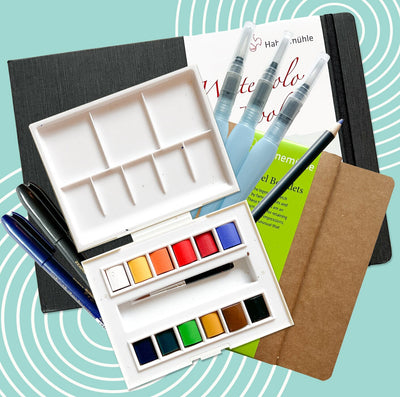Happy August Muse Kit Friends!
It's that time again, time to check your mail for your latest Muse Kits box! And this month, we have a treat for you: graffiti!
Obviously, we can’t supply you with the actual spray paint and a blank wall for you all to go wild on, but we have shrunk it down as best we could so you can make a small-scale piece to decorate your walls with.
However, in this month’s blog, we want to explore where this medium began and why it is so important. Confined to museums and art galleries, the majority of the world’s greatest art has been exclusive to the upper classes for decades. The working classes often couldn’t afford the fee to enter these places or weren’t let in at all. Graffiti art, on the other hand, has always been for the people, for the masses to see as they experience a city. It makes art accessible even to those who think they have no appreciation for it.
Graffiti is an art form that takes expresses itself for the world to see, and we want to share with you how this phenomenon got started, so let’s dive right in!
Where Did Graffiti Start?
As we mentioned in the brochure, the original graffiti art is cave paintings that our ancestors adorned their walls with, using them to tell stories and document their lives. It's clear that graffiti has a rich and lengthy history that most probably overlooks.
The way modern graffiti started is an origin story that epitomizes graffiti as protest art. It all started with tags. These were small artist pseudonyms that were quickly spray painted like a signature onto walls, signs, and other urban furniture. When they appeared in Philadelphia in the ’60s, they were used by opposing gangs to mark off their territory. But who started this tradition? Well, it was a little boy named Cornbread.
As with so many forms of art, graffiti was grown by people of color. In 1965, Darryl ‘Cornbread’ McCray started spray painting his tag ‘Cornbread’ around Philadelphia. He quickly became obsessed with leaving his mark in as many places as possible, pushing the boundaries more and more until, inevitably, he came face to face with the law. Cornbread would go on to have a contentious relationship with law enforcement for years on end until he officially retired. His most daring stunt was to break into the Philadelphia Zo and spraypainting ‘Cornbread Lives’ on an elephant because a newspaper had mistakenly reported his death in a gang shooting.
In today’s art world, we can’t talk about graffiti without talking about Banksy. Active since the 1990s, Banksy is an anonymous artist that came up in the underground Bristol art scene before making his way to London. His work mainly uses stencils that are quickly placed and executed at night, but he has also experimented with 3D street art. His artworks and mysterious personality have become famous worldwide and have played a part in changing people’s minds about graffiti as a whole.
These are just two examples, but there are thousands of artists, past and present, across the world that have kept this art form alive for decades.
How Graffiti Makes Art Accessible
As we mentioned before, when art galleries and museums were created, there was a large gap between the average working person and the average visitor to an art gallery, and, in a lot of ways, that hasn’t really changed.
While many free galleries exist, many notable works still need to be discovered behind a considerable museum or gallery fee. As art lovers, we would all probably be happy to pay to see art and take time to visit art galleries in our free time. But that’s not the case for a lot of the general public, and that’s a shame because art should be for everyone. That’s why graffiti is so important.
Now I know that most of us, when asked to picture graffiti, usually think of spraypainted lettering and small tags in public areas but there is so much more to this artform that many people give it credit for. A lot of art snobs label graffiti as vandalism and, in doing this, ignore some crucial artists and artwork that are just as valid but presented in a more public, casual setting. Even the smallest tag is a symbol, an act of rebellion and of reclaiming your city.
Layers of ever-changing graffiti grow and change along with the city it adorns. Fleeting moments can be documented in a photograph of that street art at that exact moment in time, or it can be left to change without permanent observation. That’s the beauty and unique quality that graffiti has over all others.

Graffiti vs. Mural Painting
Graffiti and mural painting are very similar art forms, but what is the difference?
New York City city councilor Peter Vallone has been quoted saying that he only considers graffiti that has been done with permission to truly be art, and that is, unfortunately, a sentiment shared by many. The distinction most people make between these two is that mural art is larger scale and often more complex because the artist has permission and may even have got paid to make this work over a few days. Graffiti, on the other hand, is smaller and less detailed because the work has to be done surreptitiously in one sitting as, in most cases, it's being done illegally.
The thing is, mural art and graffiti use very similar techniques and often the same materials to execute. The only thing standing in the way is technical legality.
In our eyes, many legendary artists could be considered graffiti artists because of their work on murals for various clients, including Leonardo da Vinci! If the only main differences between the two forms are due to their legality, then is the art itself really that different? We’ll leave you to ponder that one.

Graffiti as a Sub Culture
We can’t really talk about graffiti art without acknowledging the subculture that surrounds it. The graffiti that most of us see as we move around our home cities are tags and their large-scale counterparts that seem to pop up overnight.
These artworks are created under cover of night because it is an illegal act that can get the perpetrators arrested and charged with vandalism, as we saw when we met Cornbread earlier. But these vigilante artists have worked out a system, often acting in groups with lookouts, to make their mark and spread their work while evading law enforcement.
We once met a man, who will remain nameless for obvious reasons, that used to spend his nights spraypainting graffiti onto trains in Cape Town as they sat dormant in their stations. This was hugely risky, and he came close to getting caught by law enforcement many times, but still, his art races through the city for everyone to see.
Banksy is an artist that, while being commercially very popular, works hard to carry the tradition of secrecy and anonymity into the way he makes his art. Which is why we don’t know who he is to this day. He could easily use the medium of graffiti to make a big statement and earn worldwide fame, but instead, he respects the tradition of the medium and keep his identity in the shadows.

After all this exploration into graffiti, we have a whole new respect for this art form, and we hope it’s the same for all of you. The graffiti you create from our box may be small-scale, but maybe this will spark something in you that lets your art expand onto a larger canvas, even onto your walls. We can’t wait to see what you come up with.




